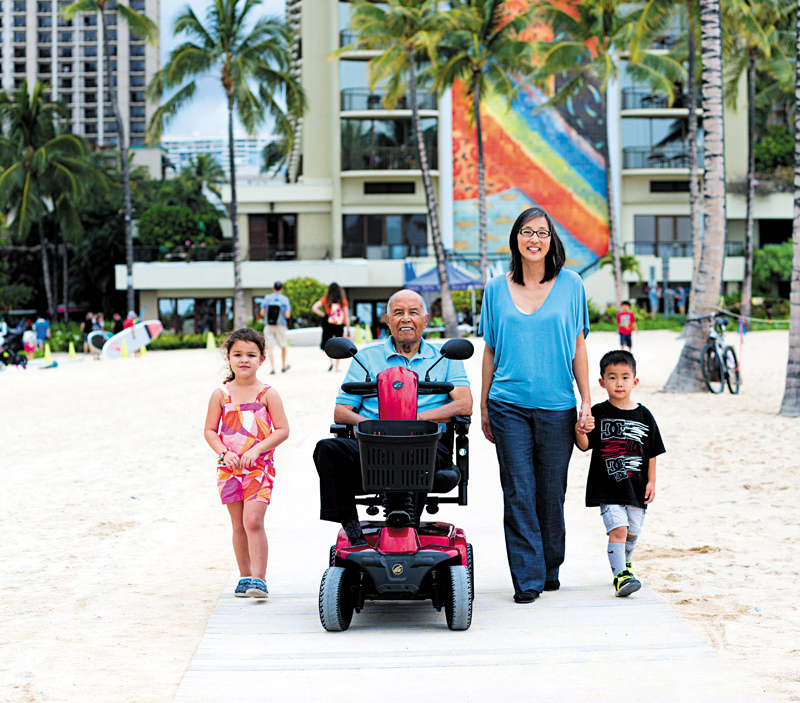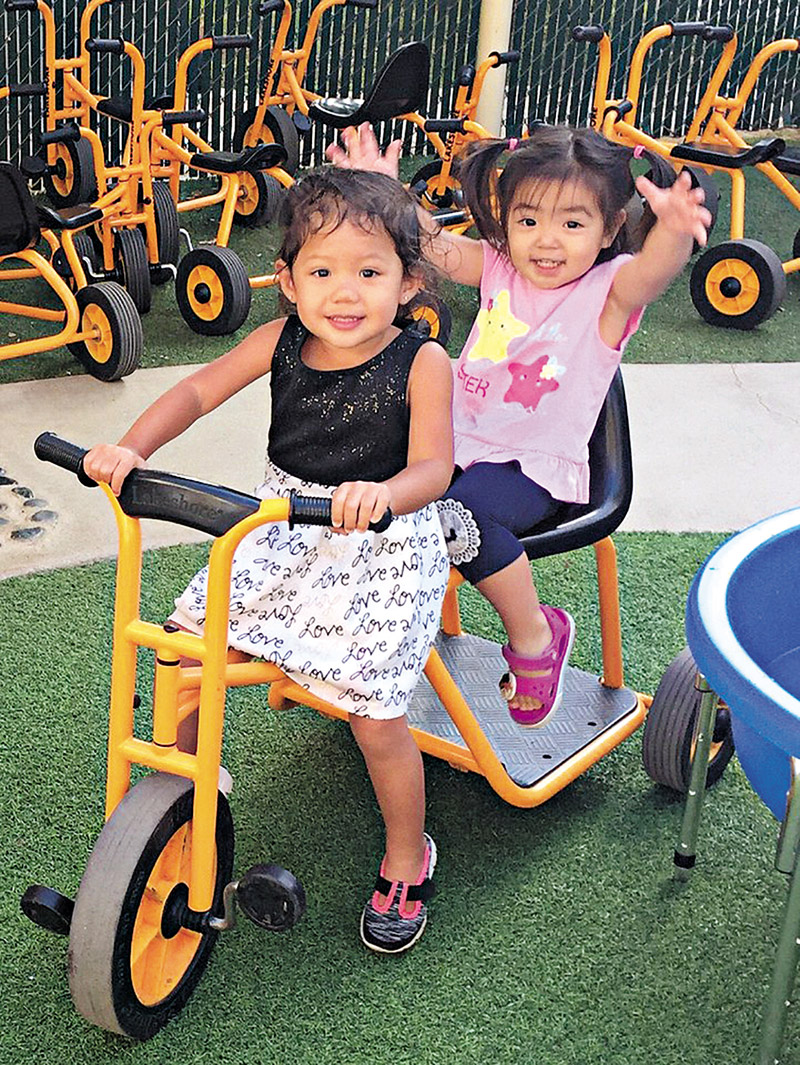The Jewel Of Waikiki

Waikīkī Community Center president Caroline Hayashi takes a stroll along Hilton Hawaiian Village Lagoon and Duke Kahanamoku Beach with center beneficiaries Haydn Barbour, Roland Jefferson and Ian Kim.
There are hidden treasures across Hawai‘i, from legends of buried jewels in mountain caves to the unknown burial site of King Kamehameha the Great. Hawai‘i is rich with mystical and uncovered stories.
But there’s a diamond in the rough that’s tucked away at the end of a quiet street steps away from Hawai‘i’s tourist mecca — a glowing gem that sits secluded in Waikīkī. Yet, this hidden jewel —Waikīkī Community Center, or WCC — is really not a secret at all, at least not for the thousands of people who walk through its humble doors every year.
“We serve about 20,000 people every year, and when you add the other groups and organizations that utilize the center, there are about 95,000 people who pass through here,” says the center’s president, Caroline Hayashi. “In Hawai‘i, relationships are important, and there’s a responsibility, or kuleana, that we support people who are struggling. That’s what we have in Waikīkī.”
For 40 years, WCC has been a safe haven for thousands of people, providing crucial multigenerational services and programs. The center is a one-stop shop for human services, social assistance and wellness, and provides support for anyone who needs it.
“I love the African proverb, ‘Sticks in a bundle cannot be broken,'” Hayashi says. “We made a strategic decision to focus on areas where we feel we can make an impact and we’re doing that.”

The center’s preschool and early education center currently serves 105 keiki. PHOTO COURTESY WCC
Duke Kahanamoku Beach Challenge
WCC depends heavily on volunteers, government grants and individual donations. It also relies on money raised from two annual fund-raising events.
“More than 20 percent of our budget comes from our charitable events, the Duke Kahanamoku Beach Challenge and the Waikīkī Lights, which is our more traditional gala fundraiser dinner at the Hilton,” says Hayashi. “Companies have 10-person teams and they do canoe, kayak and SUP races, and they get pretty competitive.”
This year’s marks the 33rd iteration of the event, which will happen this Sunday, April 15, at the Hilton Hawaiian Village Great Lawn, Lagoon and Duke Kahanamoku Beach, where Kahanamoku grew up surfing and paddling.
“We have a $2.8 million budget, and half our revenue comes from earned income and the rest comes from events and corporate and individual donations,” Hayashi explains. “We run efficiently and we want to continue to meet the needs with quality service and be able to sustain ourselves for the long term.”
Serving Waikīkī’s Keiki And More
WCC’s Preschool and Early Education Center is one example of how the center is fulfilling its mission. The center provides tuition assistance for pre-kindergarten children who come from low- to moderate-income working families.
“Five years ago when I first got here, we had 35 children, and now we serve 105 children from 14 months to 5 years,” says Hayashi, the former chief operating officer for Girl Scouts of Hawai‘i. “We’re totally maxed out, and it’s hard to find a preschool in this area that’s dedicated to providing a quality education for lowto moderate-income families.”
While there’s no requirement that a child must be from Waikīkī, state figures show that many families who call the area home are made up of single parents with children age 5 and under.
“People think Waikīkī is luxurious and wealthy, and it is in some ways when you see the luxury hotels,” Hayashi reflects. “But there are many single parents here who are struggling, so we keep our regular tuition rates as low as possible.”
But not everyone lives in Waikīkī. Some of these single parents work in the visitor industry.
“Waikīkī is our economic engine and to support a visitor industry; we need an incredible number of service workers and a lot of those jobs are not high-paying jobs,” says Hayashi. “If they can’t afford quality education for their children and they can’t afford housing, food and everything else, then we’re definitely failing our community and it’s going to catch up with us and affect us economically.”
Despite the obvious needs, there were some who questioned if the center should close the preschool and sub-lease the space to generate much-needed revenue.
But that discussion was short-lived. Closing the preschool would go against everything the center represents.
“We didn’t see another option where there would be the same commitment in serving our lowerand moderate-income families,” Hayashi explains. “Quality early education is the cheapest and most effective way to intervene and have a positive influence on a child’s life. Once you miss that opportunity and they enter kindergarten, it’s more difficult and expensive to get them up to par and some of them never catch up.”
Senior Living Never Looked So Good
Research shows that more than 30 percent of Waikīkī’s population is over the age of 60, and many kūpuna live alone. Some need housing, while others require food, financial, legal or medical help.
“Waikīkī has one of the highest concentration of seniors living in one area in the country,” says Hayashi. “Some are well off, but many are on a low fixed income who don’t have family support around them, so we become their support. Our job is finding a way to build a community around them.”
WCC helps kūpuna gain access to resources by working with other nonprofits, government agencies, private businesses, individual volunteers, private landlords and anyone who will partner with the center.
From yoga and Zumba to salsa sizzle and one of the best hula classes in Waikīkī, the center empowers 6,400 seniors to live active lives. Other activities include line and tap dancing, language classes, music, arts and crafts, and group outings.
“We look for ways to allow them to remain independent for as long as possible,” Hayashi says. “About 65 percent of the seniors that come here are from Waikīkī, but the rest come from all over the island. We have seniors coming from Kāne‘ohe to Hawai‘i Kai and all over. Many seniors say that coming to the center is the only consistent and meaningful contact they have with others.”
Serving A WWII Veteran
One of their latest success stories involved a World War II veteran who was living on the streets.
“He was homeless due to depression and got attacked twice in a month,” notes Hayashi. “He had a stroke, so he was paralyzed on one side and was afraid he couldn’t survive anymore on the streets.”
That’s when his church turned to Hayashi and her staff for help.
“We worked with a church, we worked with a real estate agent, we worked with a resident manager of a building that gave him temporary housing,” she recalls.
This continued for nine months until he received low-income senior housing.
“We worked with a moving company and individual volunteers. It was a real community-building effort just for one person,” says a grateful Hayashi. “Today, he is in stable senior housing.”
The Coconut Wireless
Locals understand the reach of the “coconut wireless.” Communicating through word-of-mouth is far more efficient and faster than any smartphone or mobile device.
That certainly is the case at WCC, where there is no need for marketing.
“We’ve kind of gotten the word out on the ground in the community,” Hayashi says. “Our client base for our senior case management has grown purely through word of mouth — even pre-school grew through word of mouth with no advertising.”
And the growth has been tremendous. In 2013, WCC staffers handled 187 senior cases. That number increased to 847 by 2016 — a 353 percent increase — and, even more remarkably, to 1,773 in 2017.
“Right now, we’re constrained by the numbers in our staff,” says Hayashi. “In some ways, it makes me very sad to see that there are many kūpuna that we haven’t taken care of in the way that they should be.”
It’s In Their DNA
World famous German-born diarist Anne Frank once wrote, “No one has ever become poor by giving.”
She easily could’ve been talking about WCC staffers.
“It’s really the people that make it happen. If you don’t have the people, then you don’t have any service and you don’t have any programs. It’s just a facility,” Hayashi says. “Everybody has a key role to play and everybody believes in the mission and why we’re doing this. We’re seeing the effect we have on people.”
Caring is in the WCC staffers’ DNA, and what they do on a skeleton budget is an example of what can be done. The goal now is getting others in the community to truly know what they do so they can be here for another 40 years.
“A lot of people tell me, ‘I didn’t know you were here,'” says Hayashi. “We don’t want this to be a hidden gem anymore because so many people have been served here and continue to rely on it. We still have work to do.”
It’s time this hidden jewel gets the spotlight it deserves.






